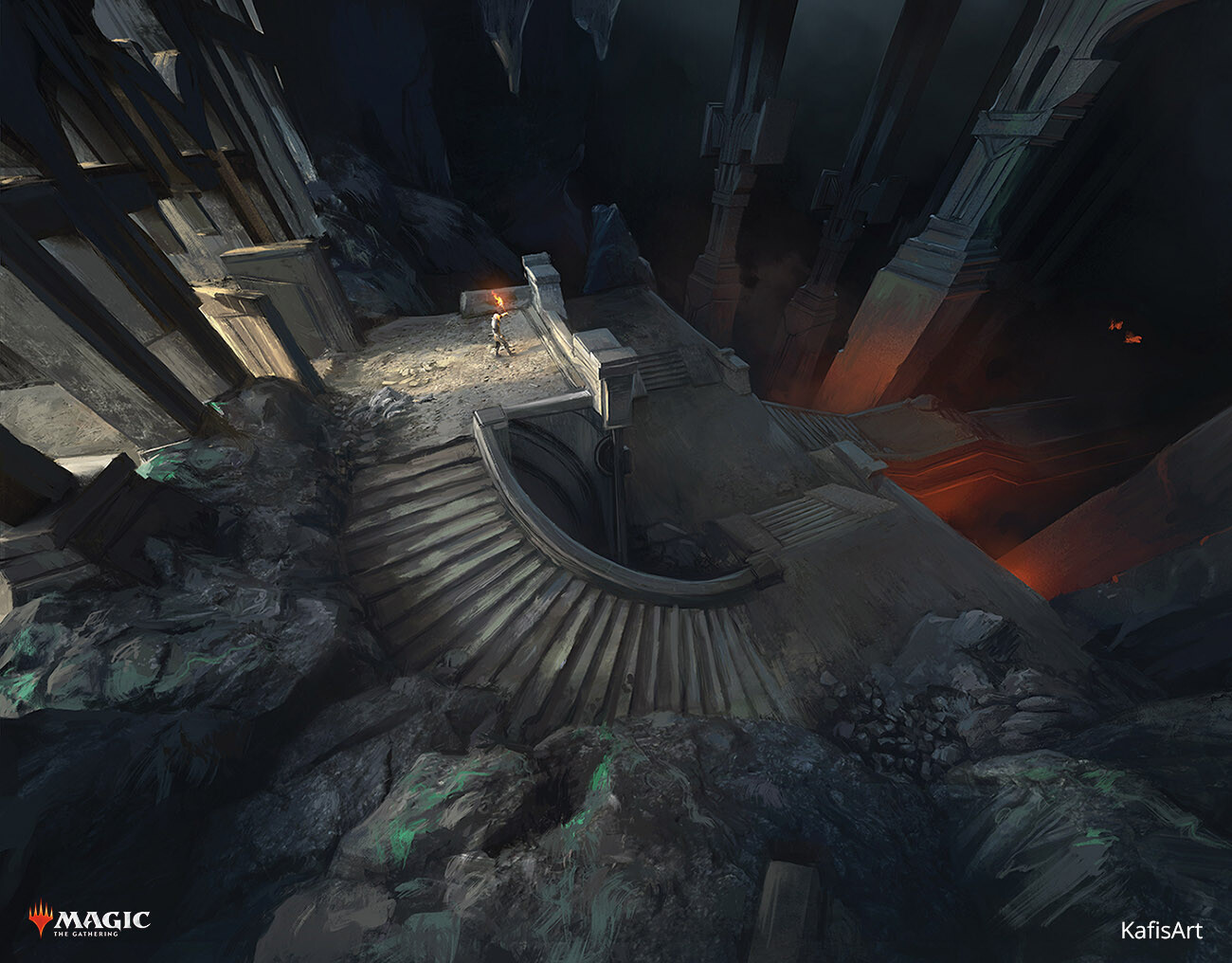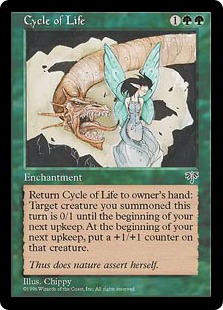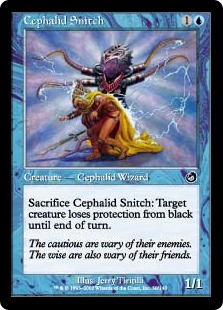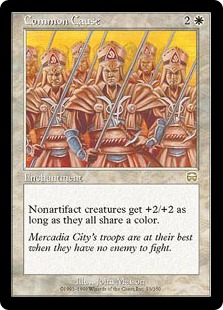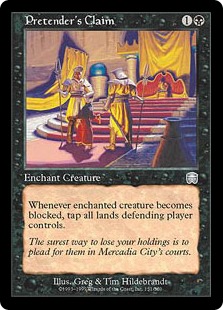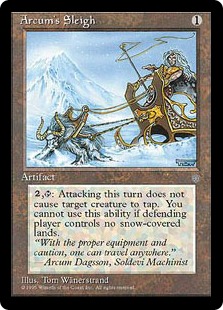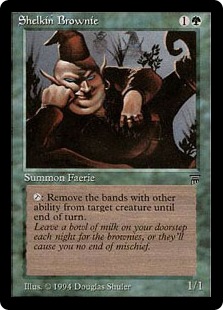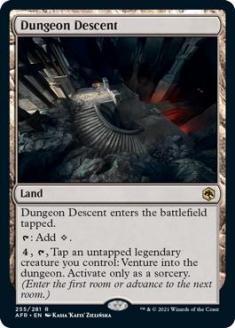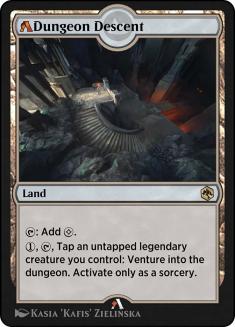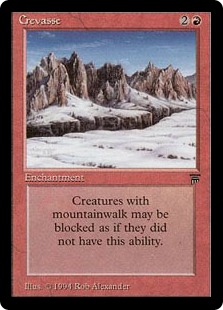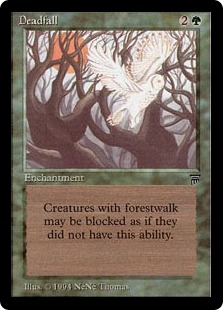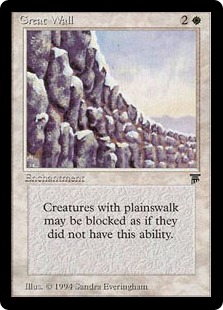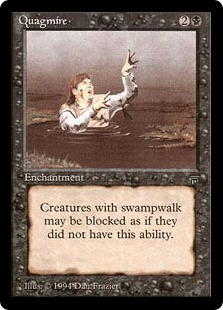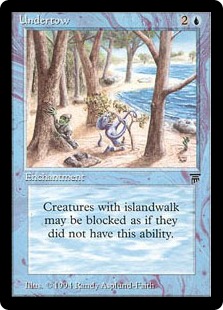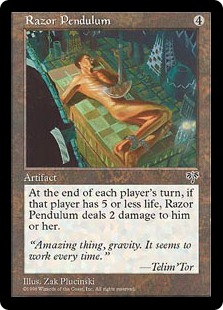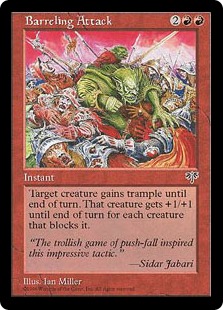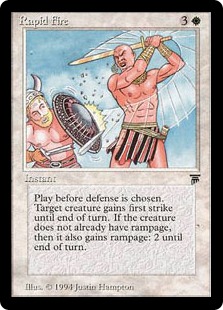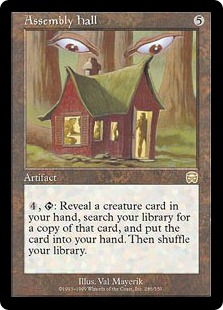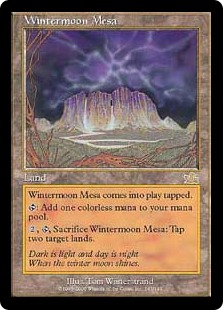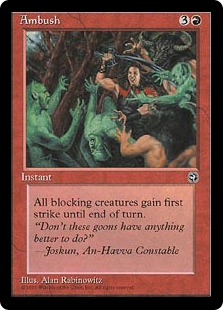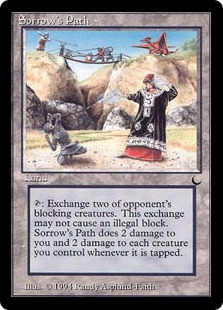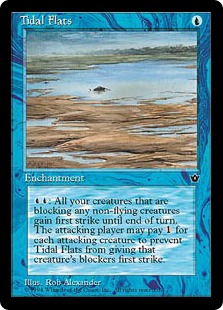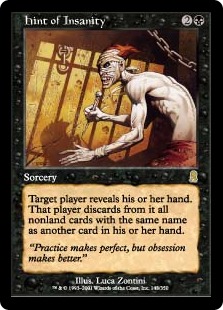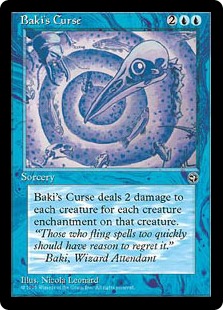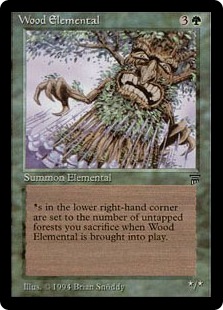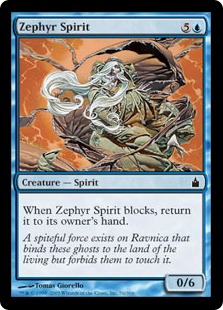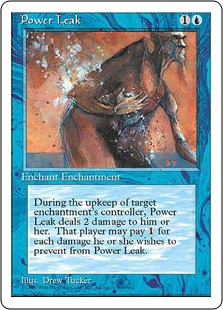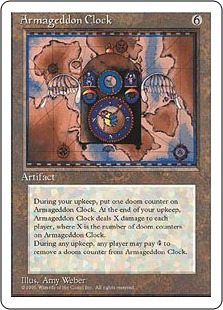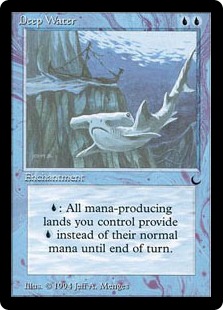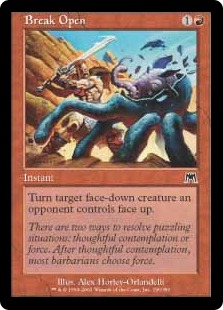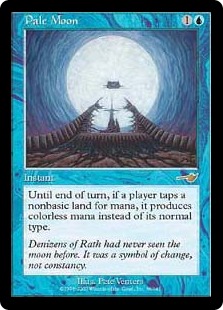And here we have it – the 25 worst Magic cards of all time. If you’ve missed any parts, you’ll find them below.
These cards are so bad, they don’t deserve much more of an introduction than this. Let’s just go straight to the list, hold our noses, and wish those intrepid deckbuilders who choose to play with these cards the best of luck.
#25 – Cocoon + Cycle of Life (Legends / Chronicles + Mirage)
Why are they bad? So here’s a good measure to see if an enchantment is bad. It’s designed for you to cast on your own side of the battlefield, but ironically it’s a card an opponent would love to actually cast themselves on your creatures. Cocoon and Cycle of Life are two such cards.
Cocoon would be a top-played removal spell if it could target an opposing creature. “Hey friend-o, Turn 1 Birds of Paradise? Let me enchant it with Cocoon! Enjoy your 1/2 flyer back on Turn 5!” As it stands, you can only cast it on your own creature. That means you lose that creature the turn you put this Aura onto the battlefield, and then lose it for the next four turns as well (three turns to remove the counters, and one to sacrifice the Cocoon – the creature is still tapped that turn).
Cycle of Life is just as bad! I’d absolutely play an enchantment that read the same as Cycle of Life, except it removed the “you cast” clause so that it could target any creature your opponent cast! Let’s turn your Toxrill, the Corrosive into a 1/1 and then kill it with Hornet Sting. What fun!
What could you play instead? Instead of Cocoon, try Forced Adaptation, which puts a +1/+1 counter on the enchanted creature each turn without a drawback, or Spider Umbra, which gives your creature +1/+1 and reach, plus is a Totem Armor. Instead of Cycle of Life, try Combine Guildmage, Cytoplast Root-Kin, Emiel the Blessed, Good-Fortune Unicorn, Ivy Lane Denizen, or any other card that just gives creatures a +1/+1 counter whenever they enter the battlefield.
#24 – Cephalid Snitch (Torment)
Why is it bad? There are six creatures in Odyssey block that already have protection from black, and three other cards that can grant/gain the ability. Cephalid Snitch was pretty useless as a common in that format, especially since the ability didn’t matter unless you were playing specifically blue and black among your colors.
In the wider realm of Magic, Cephalid Snitch is a 1/1 creature with no abilities 99.99% of the time, and enables you to two-for-one yourself by removing protection from black from a creature (presumably followed by a removal spell) the other 0.01% of the time. Black has gotten so many ways to deal with protection from black creatures over the years that it doesn’t need to resort to splashing blue or playing a creature this fragile.
What could you play instead? Any non-targeted black removal will kill a protection from black creature. Chainer’s Edict, Consuming Vapors, Custodi Lich, Dead Drop, Devour Flesh, Diabolic Edict, Gatekeeper of Malakir, Geth’s Verdict, and others are among just a few of the spells that can cause an opponent to sacrifice a pro-black critter. In addition, battlefield sweepers such as Damnation, Toxic Deluge, and their ilk also have no issue killing an entire battlefield full of protection from black creatures dead.
#23 – Common Cause (Mercadian Masques)
Why is it bad? At first glance, Common Cause looks like a playable card. “All my nonartifact creatures get +2/+2 as long as they share a color! Rock on!” But it’s not just your creatures that need to share a color. It’s all creatures that need to share a color. This means that there are two states of Common Cause – it does nothing, or it gives all (nonartifact) creatures on the battlefield +2/+2. Neither is what you want to spend a card to accomplish.
What could you play instead? Glorious Anthem gives all your creatures +1/+1, no questions asked. Tempered Steel gives a +2/+2 bonus to artifact creatures. Angelic Voices gives your white and artifact creatures +1/+1.
#22 – Pretender’s Claim (Mercadian Masques)
Why is it bad? There are many scenarios where a creature enchanted by Pretender’s Claim will either A) be blocked and have the tapping lands ability not matter, B) just be outright killed, or C) connect because the opponent wasn’t going to block anyhow. You know what isn’t going to happen? The D) scenario where your opponent is in such a bind that they absolutely have to block a creature enchanted by Pretender’s Claim, and that block causes them to tap all their mana and lose the game for some reason.
What could you play instead? Mana Short is the go-to if you just want to tap out your opponent at the end of their turn, so you can have the next turn free of countermagic/responses. See also Mistbind Clique, Nature’s Will, Mana Web, Power Sink, and the ever-spicy Piracy.
#21 – Arcum’s Sleigh (Ice Age)
Why is it bad? Arcum’s Sleigh has no effect unless your opponent controls a snow land. So we’ll start with not being able to activate it in most of your games. In the few games where your opponent does have a snow land, all you’re doing is giving a single creature vigilance for two mana. We’ve been over this earlier in the list (see Vigilance, #63) – this effect generally isn’t worth a card. While Arcum’s Sleigh can be activated repeatedly, it also can’t be activated most of the time to begin with.
What could you play instead? Ajani Steadfast can give a creature +1/+1, first strike, vigilance, and lifelink at a +1 loyalty activation. There are also numerous pieces of Equipment that grant a creature vigilance for three mana or less. These include Accorder’s Shield, Avacyn’s Collar, Cathar’s Shield, and Ring of Thune. You could also go for larger Equipment that grant vigilance, such as Batterskull, Sword of Vengeance, and Mace of the Valiant.
#20 – Shelkin Brownie (Legends)
Why is it bad? Shelkin Brownie is one step worse than Cephalid Snitch in that there are no creatures in the entirety of the history of Magic: The Gathering that were printed with the bands with others ability. Zero. Let that sink in. Here is a 1/1 creature for two mana that has no natural targets for its ability, period. The five lands from Legends that don’t tap for mana grant bands with other Legends (see #58). Master of the Hunt creates 1/1 Wolves of the Hunt tokens that band with other Wolves of the Hunt. And that, as they say, is that.
P.S. I’m not going to count Old Fogey from Unhinged, because we’re not playing in silver-bordered land in this article. So for those of you naysayers, I thumb my nose at thee!
What could you play instead? Tolaria (the original land from Legends) taps to remove either bands with other or banding from a creature. If you are so paranoid about this ability, just play this legendary land, please and thanks.
#19 – Dungeon Descent (Adventures in the Forgotten Realms)
Why is it bad? Wizards of the Coast (WotC) introduced the Alchemy format to MTG Arena in December 2021. This included not only introducing a range of online-only cards to Magic Arena, it also included buffs/nerfs to under- and overperforming cards. Dungeon Descent went from what is pictured above to this:
It still wasn’t played.
How did this card end up so bad? WotC wanted to make sure that any future dungeons printed in Magic would not end up being power-creeped by a repeatable venture effect. WotC baked in so many drawbacks into Dungeon Descent as to make it unplayable.
Drawback 1: Dungeon Descent enters the battlefield tapped.
Drawback 2: Dungeon Descent can only be activated as a sorcery.
Drawback 3: Dungeon Descent costs four mana to activate.
Drawback 4: Dungeon Descent requires you to tap an untapped legendary creature you control in order to activate.
So to recap: In the Alchemy format, Dungeon Descent no longer entered the battlefield tapped, cost three less mana to activate, and was still a bad card. That can only give you an idea of how horrible the initial iteration was!
What could you play instead? Dungeon Map enters the battlefield untapped, also taps for mana, and activates for three mana (and thankfully, no tapped legendary creatures). Fifty Feet of Rope needs four mana to activate, but also has two other abilities built in.
#18 – Crevasse + Deadfall + Great Wall + Quagmire + Undertow (Legends)
Why are they bad? Each of these cards does exactly what it’s intended to do – stop a specific type of landwalk creature. In the case of Great Wall, this includes all four creatures in Magic that naturally have plainswalk – the menaces known as Boggart Arsonists, Graceful Antelope, Righteous Avengers, and Zodiac Rooster. When your two greatest foes are a chicken and a 3/1 creature for five mana, you know that you’re pretty useless.
What could you play instead? Stopping landwalk isn’t bad if the ability goes wide. Staff of the Ages combines the abilities of all five of these Legends enchantments into one neat artifact, at the same cost. Just count it as a special bonus that Staff of the Ages stops all landwalk abilities, which also include cards like Livonya Silone and Ayumi, the Last Visitor.
#17 – Razor Pendulum (Mirage)
Why is it bad? Most Constructed formats have players begin at twenty life. Commander pushes this to 40 life. Razor Pendulum has no effect until a player is at five or less life. That is a tiny minority of the game, at which point that player will take two damage at the end of their turn. This also includes the controller of Razor Pendulum. At four mana, the best use for Razor Pendulum is discarding to Masticore (a fellow four-drop artifact) or sacrificing to Krark-Clan Ironworks (hey look, more four-drops!).
What could you play instead? Let’s say you really want to cast a four-drop artifact that can quickly finish off an opponent. May I suggest Goblin Cannon, Rocket Launcher, Fleetwheel Cruiser, Goblin Charbelcher, Jade Statue, Phyrexian Processor, Time Bomb, Wand of the Elements, or Whirling Catapult instead?
#16 – Barreling Attack (Mirage)
Why is it bad? I advised against Primal Frenzy in an earlier article. Let’s take Primal Frenzy. Make it cost four mana. Then we’ll add a second ability: you cast Barreling Attack on a creature, it gets +1/+1 for each creature blocking it when it becomes blocked this turn.
Just to make sure that you’re reading this correctly, this is no combat trick. If your creature has already been blocked, it does not get a +1/+1. You have to cast Barreling Attack before blockers are declared to get that sweet, sweet +1/+1 bonus. The realistic best-case scenario is that Barreling Attack will give your attacking creature +1/+1 and trample for four mana. It’s more likely your creature will get trample and no stat bonuses. That’s a lot of nothing at four mana.
What could you play instead? Brute Strength gives a creature +3/+1 and trample for half the mana cost of Barreling Attack. Invigorated Rampage grants +2/+0 and trample to two creatures or +4/+0 to one creature at two mana. Run Amok gives an attacking creature +3/+3 and trample for two mana. Rush of Adrenaline gives +2/+1 and trample for a single red mana.
#15 – Rapid Fire (Legends)
Why is it bad? Take Barreling Attack, swap out trample for first strike, and swap out +1/+1 for rampage 2, and there you have Rapid Fire. Rampage only works for creatures past the first blocking the creature with rampage, so I’m giving Barreling Attack points for at least letting you maybe get through for lethal trample damage at four mana. Rapid Fire will never ever be a surprise, since you have to cast it before blockers are declared.
What could you play instead? At one mana, you could play Hope Charm, Hundred-Talon Strike, or Seize the Initiative to grant a creature first strike (and often more) at instant speed. At two mana, this expands to Aerial Maneuver, Battlefield Promotion, Guided Strike, Lightning Blow, Skillful Lunge, and Zealous Strike. Note that all of these function after blockers are declared – which is the entire point of an instant granting a creature first strike to begin with!
#14 – Assembly Hall (Mercadian Masques)
Why is it bad? Paying nine mana to search for a copy of a creature card already in your hand is a huge drain on your resources. In Commander, this effect is going to be completely useless in decks that don’t run Relentless Rats / Seven Dwarves / Persistent Petitioners.
What could you play instead? If you play Assembly Hall just to have a nine-mana way to shuffle your deck, try Soldier of Fortune or Myr Mindservant instead. If you’re looking to get more of what you already have in Commander, try Followed Footsteps or Helm of the Host.
#13 – Wintermoon Mesa (Prophecy)
Why is it bad? Wintermoon Mesa enters the battlefield tapped. Strike one. Wintermoon Mesa only taps for colorless mana. Strike two. Wintermoon Mesa is two-thirds of an Early Frost that requires you to sacrifice Wintermoon Mesa. Strike three, it’s out…of consideration for you to really play.
What could you play instead? If you want to deny your opponent mana with land, try Rishadan Port. If you want to use a land to destroy opposing lands, you have Dust Bowl, Encroaching Wastes, Ghost Quarter, Memorial to War, Strip Mine, Tectonic Edge, or Wasteland. Just don’t play Wintermoon Mesa.
#12 – Ambush (Homelands)
Why is it bad? First strike is primarily used as an offensive weapon to push your creatures through, but can also serve as a defensive measure to keep opposing creatures at bay. Red tends to play up the offensive nature of first strike, while white plays up the defensive nature. That makes a card like Ambush in the outright wrong color to begin with.
First strike is a marginal ability that requires blocking to begin with (on one side or the other) and requires that you have more power than the opponent has toughness to even matter (give or take the stray dealing of first strike damage followed by a removal spell). Relegating Ambush solely to blocking and making it cost four mana just makes it unplayable for all but the most niche of battlefield states.
What could you play instead? Bloodmark Mentor eternally grants all red creatures you control first strike at two mana. Incite War plays both offense and defense (and has other abilities) for three mana. Legion Loyalist is a favorite card to grant all attacking creatures you control first strike. Savage Offensive and Warlord’s Fury also play in this territory at both cheaper mana costs, and with significant upsides.
#11 – Sorrow’s Path (The Dark)
Why is it bad? Sorrow’s Path is the lowest-ranked land on my list of the 100 worst cards of all time. You knew that Sorrow’s Path was coming, as it’s been the poster child for worst-of-the-worst since it was released. It doesn’t tap for mana. It Shocks you and all your creatures every time you activate it. Oh, yes, and it has limited uses for swapping blockers.
So how come it doesn’t make the Bottom 10 cards of this list? It’s because of Commander. If you’re playing a deck with few-to-no creatures, or all high-toughness creatures, the drawback on Sorrow’s Path is a lot less punishing than in a game where you start with twenty life. There are times now where you can drop Sorrow’s Path early in the game and threaten to use it to mess with everyone else’s combat math for the remainder of the game. No, it’s not a card I would ever recommend playing in a one-on-one game. I’d argue, though, that if it produced even a colorless mana, it wouldn’t even make the worst cards of all time list at this point due to Commander potential.
What could you play instead? False Orders is a great way to mess with blocking as more of a surprise. Goad as an ability does a lot more to screw with combat math for opponents than Sorrow’s Path ever could. I’ll also recommend the very underrated and overlooked Invasion Plans as a card to play in your deck if you want to make everyone’s combat phase a true nightmare.
#10 – Tidal Flats (Fallen Empires)
Why is it bad? Take Ambush, make it so that it doesn’t affect flying creatures, and your opponent can spend one mana to remove first strike. Now you’ve got a truly craptacular enchantment that just sits on the battlefield, doing a whole lot of nothing.
What could you play instead? If you want to tax your opponent mana for an effect, try Rhystic Study or Smothering Tithe. Blue normally doesn’t deal in first strike at all, so why not just remove all the power of attacking creatures by playing Meishin, the Mind Cage?
#9 – Hint of Insanity (Odyssey)
Why is it bad? If you’re playing a discard spell, you want to make sure that you’re making an opponent discard. Hint of Insanity will virtually never hit anything in non-Commander play, and will actually hit nothing in Commander games.
What could you play instead? Black has a plethora of discard spells. Try Coercion, Dark Inquiry, Diplomacy of the Wastes, Doomfall, Memory Leak, Memory Theft, Never Happened, Perish the Thought, Reckoner Shakedown, or Toil of the Invasion, if you just want to pluck a card of your choice out of an opponent’s hand for three mana.
#8 – Baki’s Curse (Homelands)
Why is it bad? Baki’s Curse only deals damage to enchanted creatures, and we’ve already established the creature Auras are among the worst card subtypes in the game for card advantage reasons. Moreover, the decks that Baki’s Curse would most be effective against are decks that want to pile on multiple Auras. This includes creatures like Rabid Wombat, Champion of the Flame, Evershrike, Graceblade Artisan, Kor Spiritdancer, and Uril, the Miststalker.
Want to know what all these creatures have in common? They all get +2/+2 for each Aura attached to them! So essentially Baki’s Curse says, “Do nothing against the creatures and decks that Baki’s Curse was specifically designed to hose!” This is the rare hoser that fails to actually hose what it’s trying to hose at all!
What could you play instead? Use countless white or green cards to destroy all enchantments. If you’re insistent on hosing Auras in blue, I’d suggest Evacuation, any Unsummon-type effect, Aura Flux, Kiora’s Dismissal, Aura Graft, Enchantment Alteration, or Fumble instead. Also noting that Aura Barbs in red has the same issues that Baki’s curse has as far as killing Enchantress-related creatures, but it at least will deal a massive amount of damage directly to the enchantment’s controller as well.
#7 – Wood Elemental (Legends)
Why is it bad? Many put Wood Elemental at the top of their worst creatures of all time list. I have it as the second-worst. It’s a 0/0 for four mana. Wood Elemental gets bigger as you sacrifice untapped Forests when cast – meaning you have to have at least five mana available to keep Wood Elemental alive as a 1/1 creature when it enters the battlefield.
Let’s say you get to eight mana. You’ve got yourself three dead Forests and a 3/3 creature. Look, all concessions to you people who play Titania, Protector of Argoth and say, “But but but but you also create three 5/3 creatures!” I’m going to say, “Okay, and for all those times you didn’t have Titania on the battlefield?” Horrible city.
What could you play instead? Any other creature in Magic – except the one that’s even worse than Wood Elemental. Speaking of…
#6 – Zephyr Spirit (Ravnica)
Why is it bad? When I wrote the first iteration of this list back in February 2004, the latest set included was Mirrodin. When Ravnica was released the very next year, I immediately made a note to include Zephyr Spirit in my list of worst creatures of all time. Here we are, seventeen years later, and I’m keeping a promise to myself. Zephyr Spirit is officially my worst creature of all time. It costs six mana, has a horrible stat line for six mana, and needs to be recast when it blocks. I’m pretty sure that Zephyr Spirit could have cost two mana as a 0/6 with no drawbacks and would have been just fine. This is truly the pinnacle of useless creatures.
What could you play instead? Aegis Turtle is a 0/5 creature for a single blue mana. That will give you an idea of how horrible the stats and abilities of Zephyr Spirit truly are! I mean, sure, it’s only five mana more and returns to your hand when it blocks, but at least Zephyr Spirit gets one more point of toughness. Right? This becomes even worse when you consider that Zephyr Spirit is in the same set, color and commonality as Drift of Phantasms.
Zephyr Spirit is so bad, I’ll make up having to expose you to it by posting an impromptu list of the top five creatures of all time that cost exactly 5U to cast.
#5: Spawning Kraken
#4: Tomorrow, Azami’s Familiar
#1: Kappa Cannoneer
#5 – Power Leak (Alpha / Beta / Unlimited / 3rd Edition / 4th Edition)
Why is it bad? Everything I said about Baki’s Curse goes even more so for Power Leak. At least Baki’s Curse might accidentally kill an occasional creature. Power Leak does nothing to affect the battlefield. It can easily be circumvented by mana or life payments. This is Erosion (#27) all over again, except that enchantments are one of the two least-played card types in Magic.
What could you play instead? Aura Flux will do what Power Leak does, but on a much larger scale and with the ability to actually get rid of the enchantments. If you really are just fixated on this mechanic, play the superior Feedback, which will guarantee one damage a turn on whatever enchantment it enchants. Aura Barbs (previously mentioned) will also smash pretty hard to the dome if an opponent has too many enchantments.
#4 – Armageddon Clock (Antiquities / 3rd Edition / 4th Edition)
Why is it bad? Here you have a six-mana artifact that won’t deal any damage the turn it enters the battlefield. During your next turn, it’ll deal one damage to all players, including yourself. The drawback? Any player can pay four mana to remove one of those counters, and they can do it during any upkeep. That means that Armageddon Clock will never, ever deal damage if the opponent really needs it to not deal damage. This is trivial in a Commander game.
What could you play instead? Let’s say you want to ensure dealing damage to each player every turn. Try Copper Tablet or Barbed Wire instead. If you want a big boom to build up over time, I’d recommend Time Bomb, Torch Song, or Shrine of Burning Rage.
#3 – Deep Water (The Dark)
Why is it bad? Again, mana-fixing is fine as long as it costs very little mana up front and can happen early enough in the game. If you are able to cast Deep Water, you’ve already gotten two blue sources available. What more mana-fixing do you need to make the rest of your lands produce blue mana? You don’t! Maybe if Deep Water turned all your lands into Islands, it would matter for cards like Engulf the Shore, Scourge of Fleets, or Vedalken Shackles. But alas, it only lets your lands produce blue.
What could you play instead? Stormtide Leviathan turns all lands (including other players’ lands) into Islands. However, Stormtide Leviathan costs eight mana to cast. I don’t want to copy and paste all the cheap mana-fixing artifacts that are out there from the Celestial Prism entry, so instead I’ll just name the best generic one – Chromatic Lantern.
#2 – Break Open (Onslaught)
Why is it bad? There are very few morph creatures that have worse stats than 2/2. That alone makes Break Open an extremely dicey proposition to use – the majority of the time, you’re just going to upgrade an opponent’s creature! In addition, many morph creatures have triggers that occur when they are turned face up. Break Open will trigger those effects! So not only are you likely making your opponent’s creature bigger, but you’re also giving your opponent a bonus effect. There is no mana cost at which this effect would be playable as-written. You could make Break Open a colorless instant that cost zero mana, and it’d still be the second-worst card of all time.
What could you play instead? Shock kills morph creatures dead. Cast Shock. Cast Lightning Bolt. Cast any spell that deals two or more damage because you’re the red mage. You kill things! Why are you trying to help your opponent? It’s not like they are playing Scornful Egotist (honorable mention, but not appearing on this list).
#1 – Pale Moon (Nemesis)
Why is it bad? Pale Moon was the worst card in Magic’s history eighteen years ago, and it’s the worst card in Magic’s history now. The best case use of Pale Moon is shutting down the colored mana of players for a single turn. They can still tap these lands for colorless mana. They can still use the abilities of those lands. They can still tap those lands for mana in response to Pale Moon, allowing them to have colored mana during their turn anyhow. They can still use artifacts that produce colored mana to get around Pale Moon. They can still use creatures that produce colored mana to get around Pale Moon. Casting Pale Moon is akin to taking a mulligan on Turn 2 of the game. This is a card whose true best use is discarding it to a card that requires a discard as payment.
What could you play instead? If you want to grief your entire table in blue, try Reality Twist or Naked Singularity. If you want to punish your opponent for playing nonbasic lands, everyone loves Blood Moon, right? If you want to just lock your table out of colored mana period, Ritual of Subdual is one of the ultimate griefer cards available in Commander.
And there you have it – the 100 Worst Magic Cards of All Time! I hope you’ve enjoyed this stroll though the worst of the worst that Magic has to offer. Have questions or want to take issue with any cards appearing (or not appearing) on this list? Join the conversation on Twitter @StarCityBen, and thank you for taking the time to read through these articles.

